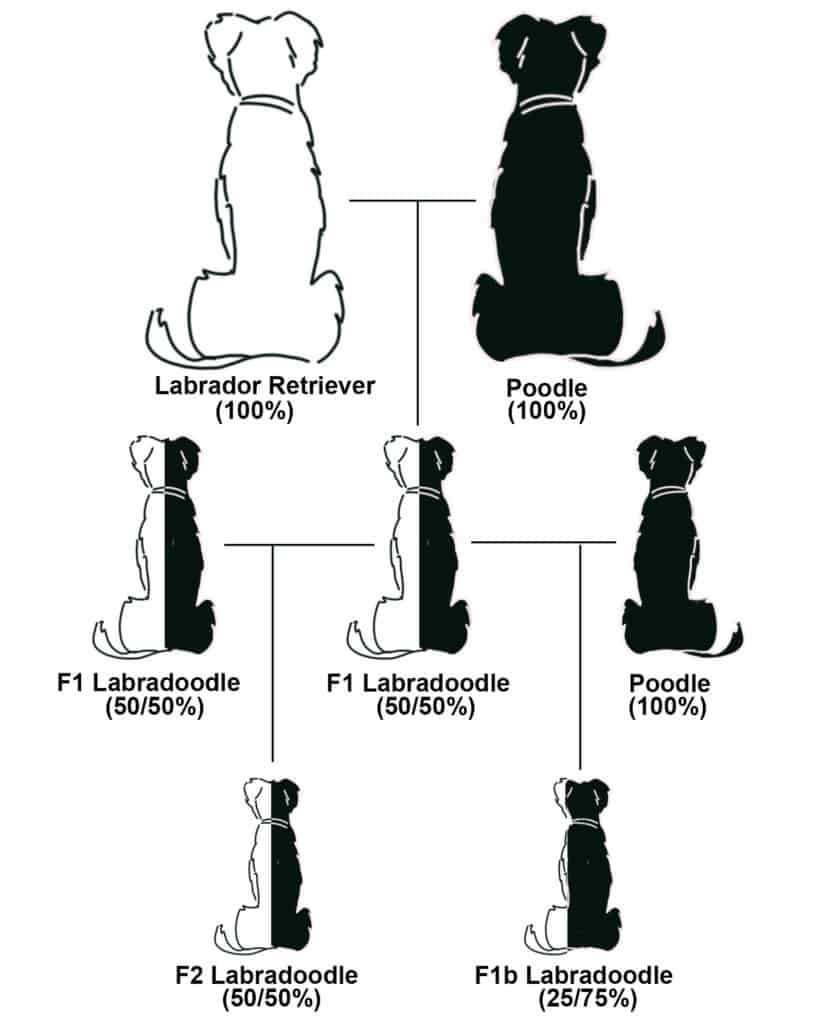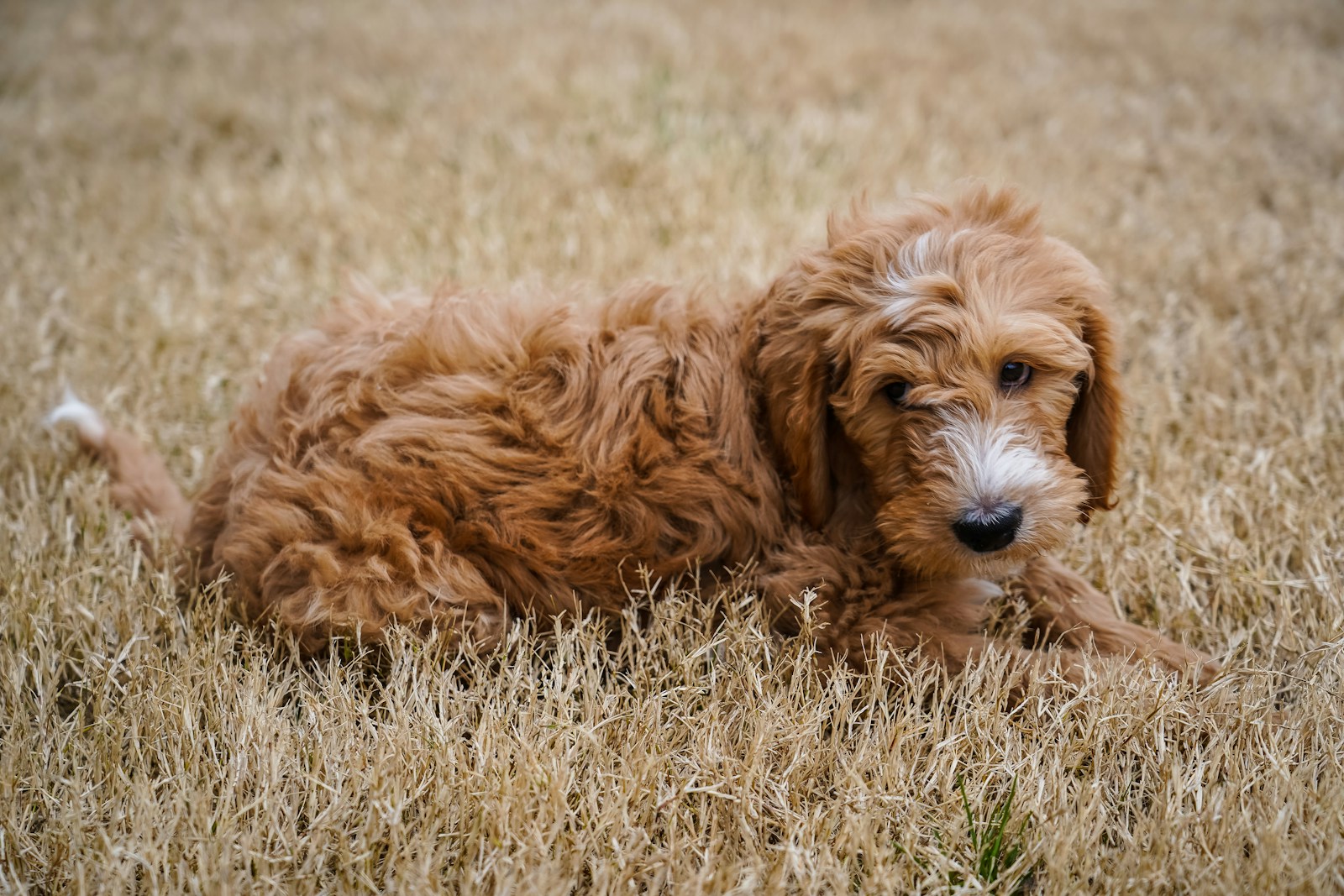F1 vs. F1B Goldendoodle: Key Differences, Shedding, and Best Choice for You
Goldendoodles are one of the most popular hybrid dog breeds, and for good reason. They blend the friendly temperament of a Golden Retriever with the intelligence and low-shedding coat of a Poodle. But if you’re researching Goldendoodles, you’ve probably seen terms like F1 Goldendoodle, F1B Goldendoodle, F2, F2B, and multigenerational—what do these actually mean?
To pick the best Goldendoodle for your family, it’s important to understand Goldendoodle generations, coat types, shedding levels, and genetic inheritance. Let’s break down what makes each generation unique.
- What is an F1 Goldendoodle?
- What is an F1B Goldendoodle?
- Goldendoodle Generations Explained (F1, F1B, F2, F2B, F3, and Multigenerational)
- Why Do Some Goldendoodles Shed? (Genetics & Punnett Square Breakdown)
- Are F1B Goldendoodles Really Hypoallergenic?
- What is an F1B Reverse Goldendoodle? (More Retriever Traits, Less Curl)
- How to Choose the Right Goldendoodle for You
- Finding a Reputable Goldendoodle Breeder
- Final Thoughts: Which Goldendoodle Generation is Best?
- Sources:
What is an F1 Goldendoodle?
An F1 Goldendoodle is the first-generation (50/50 mix) between a purebred Golden Retriever and a purebred Poodle. This means each puppy gets equal genetic traits from both parents, but the outcome can be unpredictable.
Traits of an F1 Goldendoodle:
- Coat Type: Wavy, straight, or curly (high variation)
- Shedding: Can be moderate (more than F1B)
- Hypoallergenic?: Less predictable; some may trigger allergies
- Personality: Balanced mix of Golden Retriever’s friendliness and Poodle’s intelligence
Since coat type in F1 Goldendoodles varies, some puppies have wavy coats (the most common type), while others may have curly coats (more hypoallergenic) or straight coats (more shedding). This unpredictability is why some owners prefer an F1B Goldendoodle.
What is an F1B Goldendoodle?
An F1B Goldendoodle is an F1 Goldendoodle bred back (backcross) to a purebred Poodle, resulting in a 75% Poodle and 25% Golden Retriever mix. The goal of this breeding formula is to create a dog with a more predictable, curly coat that is lower-shedding and more allergy-friendly.
Traits of an F1B Goldendoodle:
- Coat Type: Mostly curly (sometimes wavy)
- Shedding: Minimal to non-shedding (better for allergies)
- Hypoallergenic?: Much more predictable than F1
- Personality: Retains friendliness but often more energetic and intelligent due to Poodle dominance
Since Poodle coat genes are dominant, F1B Goldendoodles have a higher chance of inheriting curly coats that are better suited for allergy sufferers. However, this means they also require more grooming to prevent matting.
Goldendoodle Generations Explained (F1, F1B, F2, F2B, F3, and Multigenerational)
Goldendoodles are categorized by generational breeding, which affects their coat type, shedding, and predictability.
| Generation | Parent Mix | Coat Type | Shedding | Hypoallergenic? |
|---|---|---|---|---|
| F1 Goldendoodle | 50% Golden Retriever + 50% Poodle | Wavy, curly, or straight | Moderate | Unpredictable |
| F1B Goldendoodle | 75% Poodle + 25% Golden Retriever | Curly, sometimes wavy | Low to non-shedding | Best for allergies |
| F2 Goldendoodle | F1 Goldendoodle x F1 Goldendoodle | Varies | Unpredictable | Not as reliable |
| F2B Goldendoodle | F1 Goldendoodle x F1B Goldendoodle | Wavy to curly | Low to moderate | Better than F2 |
| F3 Goldendoodle (Multigenerational) | Two F2 or beyond Goldendoodles | Mostly curly | Low to non-shedding | Very predictable |
💡 The more Poodle genetics a Goldendoodle has, the more likely it is to be hypoallergenic and low-shedding.

Why Do Some Goldendoodles Shed? (Genetics & Punnett Square Breakdown)
Shedding and coat type depend on genetic dominance. Here’s a simple breakdown:
- Curly coats (Poodle-dominant) = less shedding
- Wavy coats (mixed genes) = moderate shedding
- Straight coats (Retriever-dominant) = more shedding
A Punnett square helps illustrate why F1B Goldendoodles shed less than F1 Goldendoodles:
| Parent Coat Gene | Poodle Coat (Curly) | Retriever Coat (Straight) |
|---|---|---|
| Poodle Parent (F1B) | 75% chance of curly coat | 25% chance of wavy coat |
| Golden Retriever Parent (F1) | 50% chance wavy coat | 50% chance straight coat |
Since curly coats are dominant, F1B and multigenerational Goldendoodles have more predictable, non-shedding fur.
According to the American Kennel Club, Poodles are one of the most hypoallergenic dog breeds due to their dense, curly coats that trap dander.
Are F1B Goldendoodles Really Hypoallergenic?
No dog is 100% hypoallergenic, but F1B and multigenerational Goldendoodles are the best option for allergy sufferers because:
- Curly coats trap dander, reducing airborne allergens
- Poodles produce less Can f 1 protein, the main allergen in dogs
- Less shedding = fewer allergens in the home
However, some allergy sufferers may still react to saliva and skin dander. If you have severe allergies, spend time with an F1B Goldendoodle before committing.
What is an F1B Reverse Goldendoodle? (More Retriever Traits, Less Curl)
An F1B Reverse Goldendoodle is an F1 Goldendoodle bred back to a Golden Retriever instead of a Poodle. This results in a dog that is 75% Golden Retriever and 25% Poodle, creating:
✔️ More Retriever-like personality
✔️ Straighter coats that require less grooming
✔️ Higher shedding than F1B (not hypoallergenic)
If you love the Golden Retriever temperament but want some Poodle intelligence, an F1B Reverse Goldendoodle could be the right fit.
How to Choose the Right Goldendoodle for You
- If you want a mix of Retriever and Poodle traits → Get an F1 Goldendoodle
- If allergies or shedding are a concern → Get an F1B or Multigenerational Goldendoodle
- If you want a straighter coat but don’t mind shedding → Consider an F1B Reverse Goldendoodle
Finding a Reputable Goldendoodle Breeder
When choosing a Goldendoodle breeder, look for:
✔️ Health-tested parents (OFA-certified hips, eyes, and heart)
✔️ Transparent breeding practices (ask about coat genetics)
✔️ Ethical breeding (no puppy mills!)
Avoid breeders who:
❌ Can’t provide genetic testing
❌ Sell Goldendoodle puppies before 8 weeks
❌ Don’t offer health guarantees
Final Thoughts: Which Goldendoodle Generation is Best?
Every Goldendoodle generation has its advantages:
- F1 = Balanced mix, unpredictable coat
- F1B = Best for allergies, curly coat, requires more grooming
- F2/F2B = More predictable, but not as hypoallergenic as F1B
- Multigenerational = Most consistent coat and hypoallergenic properties
- F1B Reverse = More Retriever-like but sheds more
No matter which Goldendoodle you choose, you’ll have a loving, intelligent, and loyal pet! 🐶💛
Sources:
Goldendoodle Association: “Goldendoodle Appearance”
- This page provides information on the physical traits of Goldendoodles, including coat types and colors, and discusses the genetic factors influencing these characteristics.
Deans Creek Doodles: “Goldendoodles, Allergies, Shedding & Coat Types”
- This article addresses common concerns about Goldendoodles related to allergies, shedding, and the importance of coat testing for prospective owners with sensitivities.


